César Quilodrán-Casas
DYffCast: Regional Precipitation Nowcasting Using IMERG Satellite Data. A case study over South America
Dec 02, 2024Abstract:Climate change is increasing the frequency of extreme precipitation events, making weather disasters such as flooding and landslides more likely. The ability to accurately nowcast precipitation is therefore becoming more critical for safeguarding society by providing immediate, accurate information to decision makers. Motivated by the recent success of generative models at precipitation nowcasting, this paper: extends the DYffusion framework to this task and evaluates its performance at forecasting IMERG satellite precipitation data up to a 4-hour horizon; modifies the DYffusion framework to improve its ability to model rainfall data; and introduces a novel loss function that combines MSE, MAE and the LPIPS perceptual score. In a quantitative evaluation of forecasts up to a 4-hour horizon, the modified DYffusion framework trained with the novel loss outperforms four competitor models. It has the highest CSI scores for weak, moderate, and heavy rain thresholds and retains an LPIPS score $<$ 0.2 for the entire roll-out, degrading the least as lead-time increases. The proposed nowcasting model demonstrates visually stable and sharp forecasts up to a 2-hour horizon on a heavy rain case study. Code is available at https://github.com/Dseal95/DYffcast.
Towards unearthing neglected climate innovations from scientific literature using Large Language Models
Nov 15, 2024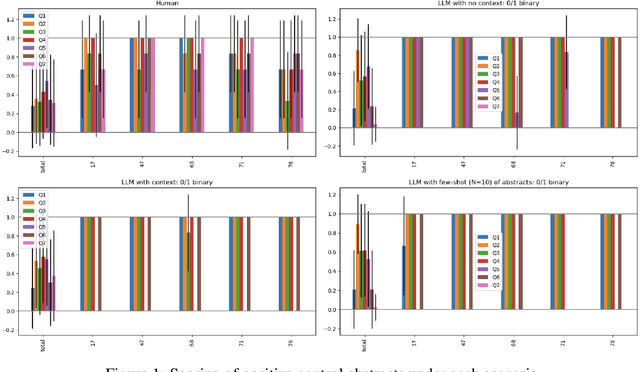

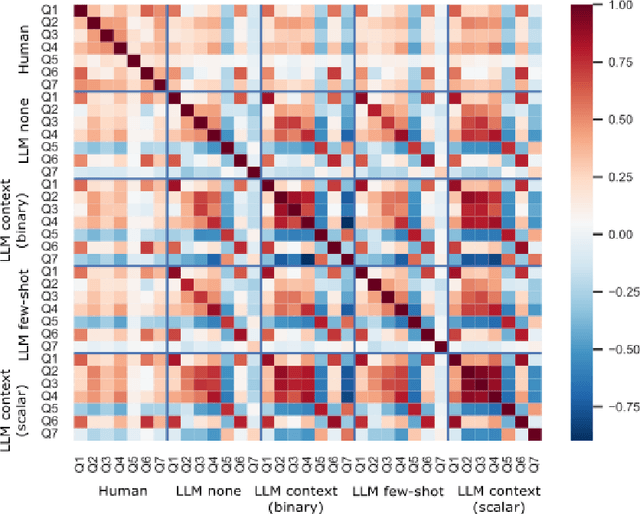

Abstract:Climate change poses an urgent global threat, needing the rapid identification and deployment of innovative solutions. We hypothesise that many of these solutions already exist within scientific literature but remain underutilised. To address this gap, this study employs a curated dataset sourced from OpenAlex, a comprehensive repository of scientific papers. Utilising Large Language Models (LLMs), such as GPT4-o from OpenAI, we evaluate title-abstract pairs from scientific papers on seven dimensions, covering climate change mitigation potential, stage of technological development, and readiness for deployment. The outputs of the language models are then compared with human evaluations to assess their effectiveness in identifying promising yet overlooked climate innovations. Our findings suggest that these LLM-based models can effectively augment human expertise, uncovering climate solutions that are potentially impactful but with far greater speed, throughput and consistency. Here, we focused on UK-based solutions, but the workflow is region-agnostic. This work contributes to the discovery of neglected innovations in scientific literature and demonstrates the potential of AI in enhancing climate action strategies.
Estimating atmospheric variables from Digital Typhoon Satellite Images via Conditional Denoising Diffusion Models
Sep 12, 2024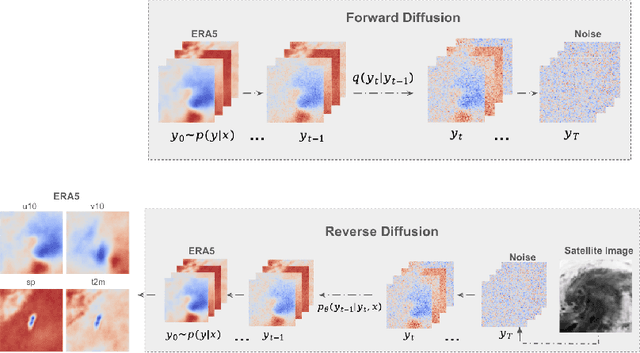
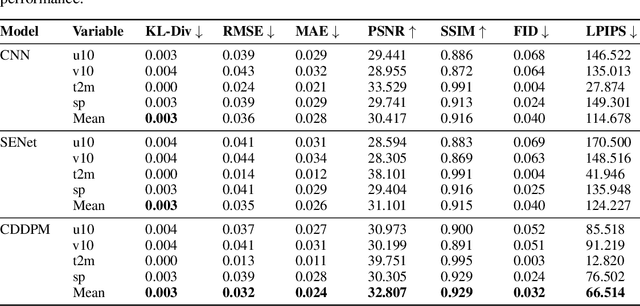

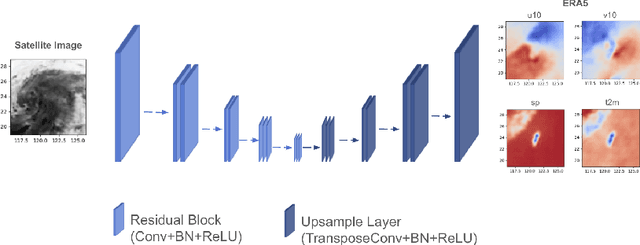
Abstract:This study explores the application of diffusion models in the field of typhoons, predicting multiple ERA5 meteorological variables simultaneously from Digital Typhoon satellite images. The focus of this study is taken to be Taiwan, an area very vulnerable to typhoons. By comparing the performance of Conditional Denoising Diffusion Probability Model (CDDPM) with Convolutional Neural Networks (CNN) and Squeeze-and-Excitation Networks (SENet), results suggest that the CDDPM performs best in generating accurate and realistic meteorological data. Specifically, CDDPM achieved a PSNR of 32.807, which is approximately 7.9% higher than CNN and 5.5% higher than SENet. Furthermore, CDDPM recorded an RMSE of 0.032, showing a 11.1% improvement over CNN and 8.6% improvement over SENet. A key application of this research can be for imputation purposes in missing meteorological datasets and generate additional high-quality meteorological data using satellite images. It is hoped that the results of this analysis will enable more robust and detailed forecasting, reducing the impact of severe weather events on vulnerable regions. Code accessible at https://github.com/TammyLing/Typhoon-forecasting.
Data Assimilation using ERA5, ASOS, and the U-STN model for Weather Forecasting over the UK
Jan 15, 2024Abstract:In recent years, the convergence of data-driven machine learning models with Data Assimilation (DA) offers a promising avenue for enhancing weather forecasting. This study delves into this emerging trend, presenting our methodologies and outcomes. We harnessed the UK's local ERA5 850 hPa temperature data and refined the U-STN12 global weather forecasting model, tailoring its predictions to the UK's climate nuances. From the ASOS network, we sourced T2m data, representing ground observations across the UK. We employed the advanced kriging method with a polynomial drift term for consistent spatial resolution. Furthermore, Gaussian noise was superimposed on the ERA5 T850 data, setting the stage for ensuing multi-time step synthetic observations. Probing into the assimilation impacts, the ASOS T2m data was integrated with the ERA5 T850 dataset. Our insights reveal that while global forecast models can adapt to specific regions, incorporating atmospheric data in DA significantly bolsters model accuracy. Conversely, the direct assimilation of surface temperature data tends to mitigate this enhancement, tempering the model's predictive prowess.
Forecasting Tropical Cyclones with Cascaded Diffusion Models
Oct 04, 2023Abstract:As cyclones become more intense due to climate change, the rise of AI-based modelling provides a more affordable and accessible approach compared to traditional methods based on mathematical models. This work leverages diffusion models to forecast cyclone trajectories and precipitation patterns by integrating satellite imaging, remote sensing, and atmospheric data, employing a cascaded approach that incorporates forecasting, super-resolution, and precipitation modelling, with training on a dataset of 51 cyclones from six major basins. Experiments demonstrate that the final forecasts from the cascaded models show accurate predictions up to a 36-hour rollout, with SSIM and PSNR values exceeding 0.5 and 20 dB, respectively, for all three tasks. This work also highlights the promising efficiency of AI methods such as diffusion models for high-performance needs, such as cyclone forecasting, while remaining computationally affordable, making them ideal for highly vulnerable regions with critical forecasting needs and financial limitations. Code accessible at \url{https://github.com/nathzi1505/forecast-diffmodels}.
Med-UniC: Unifying Cross-Lingual Medical Vision-Language Pre-Training by Diminishing Bias
May 31, 2023Abstract:The scarcity of data presents a critical obstacle to the efficacy of medical visionlanguage pre-training (VLP). A potential solution lies in the combination of datasets from various language communities. Nevertheless, the main challenge stems from the complexity of integrating diverse syntax and semantics, language-specific medical terminology, and culture-specific implicit knowledge. Therefore, one crucial aspect to consider is the presence of community bias caused by different languages. This paper presents a novel framework named Unifying Cross-Lingual Medical Vision-Language Pre-Training (Med-UniC), designed to integrate multimodal medical data from the two most prevalent languages, English and Spanish. Specifically, we propose Cross-lingual Text Alignment Regularization (CTR) to explicitly unify cross-lingual semantic representations of medical reports originating from diverse language communities. CTR is optimized through latent language disentanglement, rendering our optimization objective to not depend on negative samples, thereby significantly mitigating the bias from determining positive-negative sample pairs within analogous medical reports. Furthermore, it ensures that the cross-lingual representation is not biased toward any specific language community. Med-UniC reaches superior performance across 5 medical image tasks and 10 datasets encompassing over 30 diseases, offering a versatile framework for unifying multi-modal medical data within diverse linguistic communities. The experimental outcomes highlight the presence of community bias in cross-lingual VLP. Reducing this bias enhances the performance not only in vision-language tasks but also in uni-modal visual tasks.
Forecasting emissions through Kaya identity using Neural Ordinary Differential Equations
Jan 07, 2022

Abstract:Starting from the Kaya identity, we used a Neural ODE model to predict the evolution of several indicators related to carbon emissions, on a country-level: population, GDP per capita, energy intensity of GDP, carbon intensity of energy. We compared the model with a baseline statistical model - VAR - and obtained good performances. We conclude that this machine-learning approach can be used to produce a wide range of results and give relevant insight to policymakers
Adversarial autoencoders and adversarial LSTM for improved forecasts of urban air pollution simulations
Apr 16, 2021



Abstract:This paper presents an approach to improve the forecast of computational fluid dynamics (CFD) simulations of urban air pollution using deep learning, and most specifically adversarial training. This adversarial approach aims to reduce the divergence of the forecasts from the underlying physical model. Our two-step method integrates a Principal Components Analysis (PCA) based adversarial autoencoder (PC-AAE) with adversarial Long short-term memory (LSTM) networks. Once the reduced-order model (ROM) of the CFD solution is obtained via PCA, an adversarial autoencoder is used on the principal components time series. Subsequentially, a Long Short-Term Memory network (LSTM) is adversarially trained on the latent space produced by the PC-AAE to make forecasts. Once trained, the adversarially trained LSTM outperforms a LSTM trained in a classical way. The study area is in South London, including three-dimensional velocity vectors in a busy traffic junction.
Digital twins based on bidirectional LSTM and GAN for modelling COVID-19
Feb 03, 2021



Abstract:The outbreak of the coronavirus disease 2019 (COVID-19) has now spread throughout the globe infecting over 100 million people and causing the death of over 2.2 million people. Thus, there is an urgent need to study the dynamics of epidemiological models to gain a better understanding of how such diseases spread. While epidemiological models can be computationally expensive, recent advances in machine learning techniques have given rise to neural networks with the ability to learn and predict complex dynamics at reduced computational costs. Here we introduce two digital twins of a SEIRS model applied to an idealised town. The SEIRS model has been modified to take account of spatial variation and, where possible, the model parameters are based on official virus spreading data from the UK. We compare predictions from a data-corrected Bidirectional Long Short-Term Memory network and a predictive Generative Adversarial Network. The predictions given by these two frameworks are accurate when compared to the original SEIRS model data. Additionally, these frameworks are data-agnostic and could be applied to towns, idealised or real, in the UK or in other countries. Also, more compartments could be included in the SEIRS model, in order to study more realistic epidemiological behaviour.
Adversarially trained LSTMs on reduced order models of urban air pollution simulations
Jan 05, 2021



Abstract:This paper presents an approach to improve computational fluid dynamics simulations forecasts of air pollution using deep learning. Our method, which integrates Principal Components Analysis (PCA) and adversarial training, is a way to improve the forecast skill of reduced order models obtained from the original model solution. Once the reduced-order model (ROM) is obtained via PCA, a Long Short-Term Memory network (LSTM) is adversarially trained on the ROM to make forecasts. Once trained, the adversarially trained LSTM outperforms a LSTM trained in a classical way. The study area is in London, including velocities and a concentration tracer that replicates a busy traffic junction. This adversarially trained LSTM-based approach is used on the ROM in order to produce faster forecasts of the air pollution tracer.
 Add to Chrome
Add to Chrome Add to Firefox
Add to Firefox Add to Edge
Add to Edge